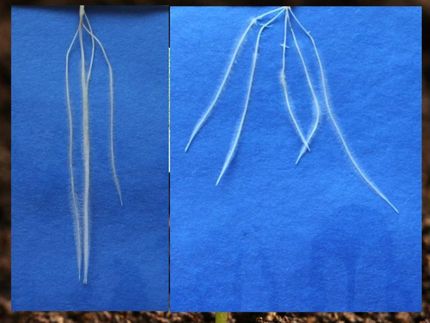Key gene for toxic alkaloid in barley discovered
Researchers have laid the foundation for improving barley
barley is one of the most important cereal crops on a global scale. Many barley cultivars produce a toxic alkaloid called gramine that affects the suitability of barley as fodder, but also helps to protect barley from pathogens. So far, the potential of manipulating gramine levels has not been harnessed for plant breeding, because the genetic basis of gramine production has been unresolved. Research groups from IPK Leibniz Institute and the Leibniz University Hannover now disclose the complete biosynthetic pathway of gramine and demonstrate how gramine biosynthesis can be introduced into model organisms or removed from barley. The results were published in the journal “Science”.
All plants mediate their environmental interactions via chemical signals. An example is the alkaloid gramine produced by barley, one of the world’s most widely grown cereals. Gramine provides protection against herbivorous insects and grazing animals and inhibits the growth of other plants. Despite long-standing interest, the key gene for the formation of gramine remained elusive.
The researchers discovered a cluster of two genes in barley for gramine biosynthesis. The first gene (HvNMT) had already been discovered 18 years ago. In their study the researchers from IPK and the Leibniz University Hannover now identified a second gene (AMI synthase, HvAMIS), and found out that both genes are located in proximity of each other on the same chromosome. With this discovery, the pathway of gramine biosynthesis is now fully elucidated.
“We discovered that AMIS is an oxidase enzyme that carries out an unusual cryptic oxidative rearrangement of tryptophan, allowing us to revise the previous biosynthetic proposal from the 1960s”, says Dr. John D’Auria, head of IPK’s research group “Metabolic Diversity”. Prof. Dr. Jakob Franke, head of the group “Biochemistry of Plant Specialised Metabolites” at Leibniz University Hannover, adds: “We were very surprised by the so far unknown enzyme mechanism by which gramine is formed. At the same time, we now have the possibility to produce biologically active alkaloids with sustainable biotechnological methods.”
The research team could produce gramine in yeast and model plants (Nicotiana benthamiana, Arabidopsis). “In contrast to many other protective metabolites from plants, production of gramine requires only two genes. Therefore, using our findings for practical applications is relatively straightforward”, emphasises Ling Chuang from Leibniz University Hannover, one of the first authors. “Furthermore, genetic engineering of barley allowed us to produce gramine in a non-gramine producing barley variety, and eliminate gramine production in a gramine producing barley variety by genome editing”, explains the other first author Sara Leite Dias, International Max Planck Research School funded researcher at the IPK.
“The results set the basis to produce gramine in organisms without the native ability to synthesize it for purposes such as a natural plant protection agent, or to eliminate gramine from barley and other grasses to reduce toxicity towards ruminants”, says Dr. John D’Auria. “Our findings set the ground for improving barley to increase its resistance to pests, reduce its toxicity to ruminants and contribute to sustainable weed management.”
Original publication
Sara Leite Dias, Ling Chuang, Shenyu Liu, Benedikt Seligmann, Fabian L. Brendel, Benjamin G. Chavez, Robert E. Hoffie, Iris Hoffie, Jochen Kumlehn, Arne Bültemeier, Johanna Wolf, Marco Herde, Claus-Peter Witte, John C. D’Auria, Jakob Franke; "Biosynthesis of the allelopathic alkaloid gramine in barley by a cryptic oxidative rearrangement"; Science, Volume 383
Most read news
Original publication
Sara Leite Dias, Ling Chuang, Shenyu Liu, Benedikt Seligmann, Fabian L. Brendel, Benjamin G. Chavez, Robert E. Hoffie, Iris Hoffie, Jochen Kumlehn, Arne Bültemeier, Johanna Wolf, Marco Herde, Claus-Peter Witte, John C. D’Auria, Jakob Franke; "Biosynthesis of the allelopathic alkaloid gramine in barley by a cryptic oxidative rearrangement"; Science, Volume 383
Organizations
Other news from the department science

Get the food & beverage industry in your inbox
By submitting this form you agree that LUMITOS AG will send you the newsletter(s) selected above by email. Your data will not be passed on to third parties. Your data will be stored and processed in accordance with our data protection regulations. LUMITOS may contact you by email for the purpose of advertising or market and opinion surveys. You can revoke your consent at any time without giving reasons to LUMITOS AG, Ernst-Augustin-Str. 2, 12489 Berlin, Germany or by e-mail at revoke@lumitos.com with effect for the future. In addition, each email contains a link to unsubscribe from the corresponding newsletter.
















































